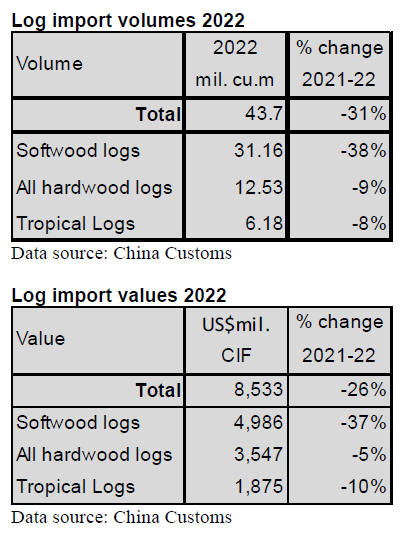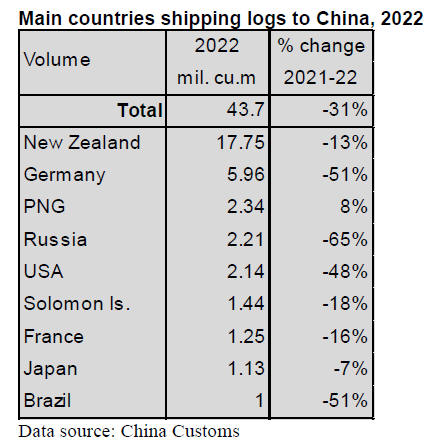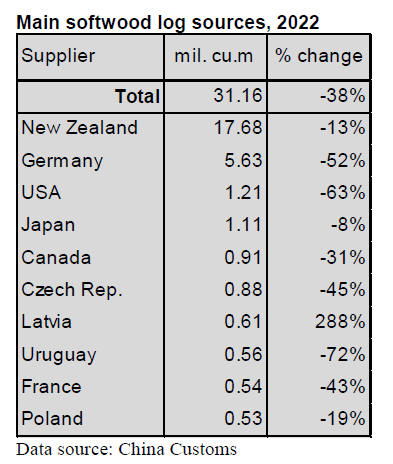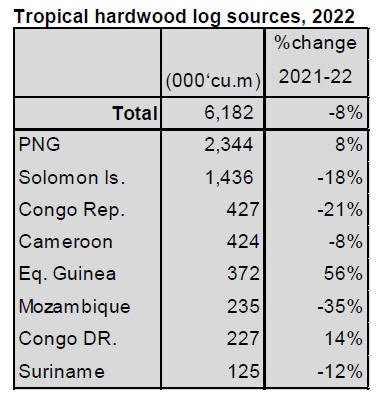US Dollar Exchange Rates of
10th
Feb
2023
China Yuan 6.78
Report from China
2022 investment in real estate tumbled
A press release the National Bureau of Statistics of China
provides data on national real estate development and
sales in 2022. This shows that there was a 10% decline in
real estate investment with investment in residential
properties dropping 9.5%.

See:
http://www.stats.gov.cn/english/PressRelease/202301/t20230118_1892298.html
In related news, during the opening remarks at a press
briefing on the IMF report for China, Thomas Helbling,
Deputy Director, Asia and Pacific Department said the
Fund projects China’s economic growth to increase from
3% in 2022 to 5.2% in 2023 driven by a rebound in private
consumption amid the earlier-than-anticipated re-opening
in China.
On the real estate sector the IMF welcomed China’s recent
policy measures but suggested additional action is needed
to end the real estate crisis, including applying funds for
completion of troubled projects as this would also help
restore homebuyer confidence and contain financial
stability risks.
See:https://www.imf.org/en/News/Articles/2023/02/01/sp-chinaaiv-press-briefing-opening-remarks
Decline in log imports in 2022
According to China Customs log imports in 2022 totalled
43.70 million cubic metres valued at US$8.533 billion, a
decline of 31% in volume and 26% in value year on year.
The average price for imported logs was US$195 (CIF)
per cubic metre, up 7% on levels in 2021.
In 2022 softwood log imports fell 38% to 31.16 million
cubic metres, accounting for 71% of the national total,
down 7% from 2021. The average price for imported
softwood logs was US$160 (CIF) per cubic metre, up 1%
on levels in 2021.
Hardwood log imports in 2022 fell 9% to 12.53 million
cubic metres (29% of the national total log imports). The
average price for imported hardwood logs in 2022 was
US$283 (CIF) per cubic metre, up 4% on 2021.
Of total hardwood log imports, tropical log imports were
6.18 million cubic metres valued at US$1.875 billion,
down 8% in volume and down 10% in value from 2021,
accounting for 14% of the national total import volume in
2022.
 
Decline in log imports from all the main
suppliers
except PNG
According to China Customs the volume of log imports
from all the main suppliers in 2022 declined except for
PNG where import volumes rose 8% to 2.34 million cubic
meters valued at US$549 million, up 11% year on year.
The average price for imported logs from PNG in 2022
rose 3% to US$234 (CIF) per cubic metre.
New Zealand and Germany were main suppliers for
China’s log imports and the proportion supplied by the
two countries was 55% of the national total in 2022.
New Zealand was the largest supplier of logs to China’s in
2022 accounting for 41% of the national total, up 9% from
2021. China’s log imports from New Zealand were 17.75
million cubic metres valued at US$2.689 billion, down
13% in volume and down 20% in value. The average price
for imported logs from New Zealand was US$151 (CIF)
per cubic metre.
Germany was ranked the second for log imports to China
in 2022 making up 14% of the national total but, down 5%
from 2021. China’s log imports from Germany totalled
5.96 million cubic meters valued at US$1.024 billion,
down 51% in volume and down 47% in value. The
average price for imported logs from Germany was
US$172 (CIF) per cubic metre.
China’s log imports from Russia plummeted 65%, from
USA, Solomon, France and Brazil log imports also
declined sharply.
 
Soaring softwood log imports from Latvia
China’s softwood log imports from Latvia in 2022 soared
288% to 610,000 cubic metres mainly because China
imported a lot of large diameter fir, spruce, Korean pine
and scots pine. China’s large diameter fir and spruce
imports from Latvia soared 451% to 523,161 cubic metres,
however, the CIF price for fir and spruce declined 23% in
2022. China’s large diameter Korean pine and scots pine
imports from Latvia rose 79% to 78,979 cubic metres, the
CIF price for fir and spruce declined 1% slightly in 2022.
Germany is the main supplier of China’s fir and spruce
imports and accounted for 67% of the national total in
2021 but fell 54% in 2022. Latvia was the main supplier of
fir and spruce imports to make up for the reduction from
Germany. While log prices generally rose in 2022, Latvian
log prices fell, hence the surge in imports, especially for
fir and spruce, down 23% year on year.
PNG the largest supplier of hardwood logs
PNG was the largest supplier of hardwood logs replacing
Russia in 2022. China’s hardwood log imports from PNG
rose 8% to 2.34 million cubic metres valued at US$549
million, up 11% year on year. The CIF prices for
hardwood log imports from PNG rose 64% largely.
China’s hardwood log imports from Russia were 2.12
million cubic metres valued at US$261 million, down 18%
in volume and 29% in value in 2022. The CIF for
hardwood log imports from Russia fell 54%.
80% of the national total log imports are from PNG (19%),
Russia (17%), Solomon (11%), USA (7.4%), Brazil
(7.1%), France (5.7%), the Republic of Congo (3.4%),
Cameroon (3.38%), Equatorial Guinea (3.0%) and
Germany (2.7%).
It is worth noting that Chinese hardwood log imports from
the US increased by 8% year on year in 2022, despite a
more than 300% jump in US log prices.

Decline in tropical log imports
PNG and Solomon Is. are the main suppliers for China’s
tropical log imports and the proportion of the two
countries in 2022 was more than 60%. China’s tropical
hardwood log imports from PNG rose 8% but from
Solomon Is. fell 18%. The average price for imported
tropical logs was US$303 CIF per cubic metre, down 2%
on levels in 2021.

Decline in log imports from Myanmar
Myanmar was a major source of tropical logs for China
before its log export ban, China’s log imports from
Myanmar have been declining for many years. China’s log
imports from Myanmar fell 43% to 6,147 cubic metres
valued at US$7.49 million, down 45% year on year in
2022. China’s log imports from Myanmar in 2021 soared
more than 300% in volume.
No log imports from Australia
China used to import more than one million cubic metres
of logs from Australia but this fell to 63,000 cu.m in 2021
and zero in 2022.
There were no China’s log imports from Australia
completely in 2022. Australia has disappeared from the list
of major suppliers of logs to China.
China’s log imports from Australia have been declining
and came to zero finally because of a ban on imports as
the quarantine service in China once again detected pests
in a log shipment. Since the beginning of 2020 the
quarantine service has reported detecting live pests such as
the long horn beetle, Cerambycidae and jewel beetles,
Buprestidae in logs imported from Australia.
GTI-China Index – January 2023
In January 2023, as covid rules were eased, domestic
demand increased and the economy began to recover. In
late January a large number of employees returned to their
home towns to celebrate the Lunar New Year which meant
output from manufacturing enterprises was affected.
However, tourism, entertainment, catering and other
service industries have shown a marked and the economy
is steadily recovering.
The development of China's timber manufacturing
industry in January showed significant off-season
characteristics due to the Lunar New Year. Compared with
the previous month, the number of workers in enterprises
and factories represented by companies contributing to the
Global Timber Index GTI-China Index declined
significantly and the production volume and orders indices
also declined. In January the GTI-China Index registered
21.5%, a decrease from the previous month and was
below the critical value (50%) indicating that the business
prosperity of the timber enterprises represented in the
GTI-China Index declined from the previous month.
The production index in January fell below the critical
value indicating that the production volume of the timber
enterprises represented in the GTI-China Index was less
than that of the previous month.
The new orders index registered from the previous month
to fall below the critical value indicating that the number
of new orders of the timber enterprises represented in the
GTI-China shrank sharply from the previous month.
The export orders index registered a decrease from the
previous month and has been below the critical value for 5
consecutive months indicating that the ability to obtain the
export orders of the timber enterprises represented in the
GTI-China difficult.
The inventory index of finished products registered a
decrease from the previous month and has been below the
critical value for 6 consecutive months indicating that the
inventory of finished products of the timber enterprises
represented in the GTI-China was declining.
The January existing orders index also registered a decline
from the previous month and has been below the critical
value for 5 consecutive months.
The purchasing quantity index has been below the critical
value for 3 consecutive months.
The purchasing price index registered a further
decline and
was below the critical value indicating that the purchasing
price of the timber enterprises represented in the GTIChina
was less than that of the previos month.
The import orders index registered a decrease from the
previous month and has been below the critical value for 3
consecutive months.
The delivery time index did not improve in January and
remains below the critical value indicating that the
delivery time from the supplier to the timber enterprises
was even slower than the previous month.
Finally, the inventory index of main raw materials
registered weakened further in January and has been
below the critical value for 6 consecutive months.


|